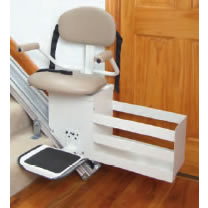Preventing Falls with a Stair Lift
Published by Stephen on October 13, 2008 Under stair lifts There are many people who have difficulty using the stairs, but those over sixty are most affected by this problem. It is often due to cognitive disorders, joint problems, poor vision, or a combination of these factors, but falls on the stairs can be very dangerous to seniors. In fact the number one cause of hospitalization and death among seniors is a fall on the stairs.
There are many people who have difficulty using the stairs, but those over sixty are most affected by this problem. It is often due to cognitive disorders, joint problems, poor vision, or a combination of these factors, but falls on the stairs can be very dangerous to seniors. In fact the number one cause of hospitalization and death among seniors is a fall on the stairs.
Since recovering from a fall can be very difficult for seniors, it is much better to prevent them before they happen. Rather than rely on family move, or a paid care worker, many people choose to install a stair lift, because it is a cost effective way to increase safety without requiring a major life change.
A stair lift is a device that carries a person from one level of a home to another. On most staircase, they can be installed directly onto the steps, but in some cases they are instead attached to the wall. They carry a single individual, usually in a chair, safely up or down the stairs, so there is little need to worry about a fall.
Most of these devices use a chair to transport their occupant along the distance of the stairs, but in some cases a platform is used. The platform lifts require that the occupant remains standing as they are carried along the stairs. As a result, these types are not as safe as the models that use chairs. Usually the chaired lift is recommended, unless there is a specific medical need to have a platform stair lift.
Those that have a straight staircase, often decide to install the lift on their own. There are several do it your self stair lift kits available. Two of the more popular lifts are those manufactured by Acorn and AmeriGlide. Both of these companies offer quality stair lifts that can be installed quickly and easily onto a straight stairway.
When choosing a stair lift, you have the option of a Battery powered stair lift or an AC powered stair lift. Both of these lifts plug directly into a regular household outlet, but battery powered lifts, run off of a battery instead of direct current. The battery is continuously charging and if the power goes out, you will still be able to use the lift.
AC powered lifts don’t work if the power goes out, but they cost a little bit less than battery powered stair lifts. Also there is a lower maintenance cost, because the batteries need to be periodically replaced in a battery powered stair lift.
In many cases, stair lifts provide an affordable alternative to a residential elevator. They generally don’t require much home modification and can be installed much more quickly. Preventing accidents on the stairs is very important and using a stair lift is an excellent way to achieve this goal.
No Comments |
Add a Comment